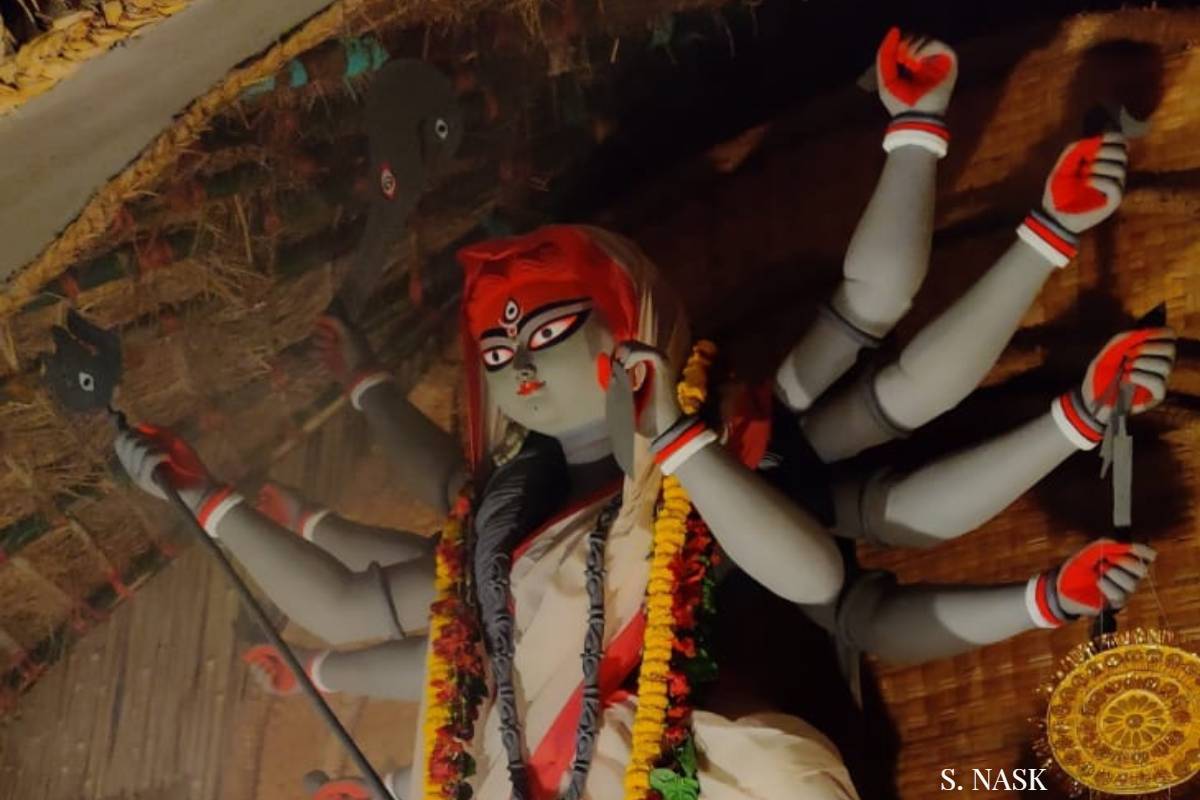“These days the festive spirit is lost somewhere”. This is a very common sentence used by elderly people amidst a Durga Puja conversation. But what exactly was different in Durga Puja of the older days? And what is missing these days?
Sushila, who is an old lady from a small village in Birbhum district of Bengal answers the questions by sharing some of her childhood stories.
The beginning of the festive preparations:
Sushila said, “Almost a month prior to Durga Puja, my mother and all the ladies of the neighborhood used to start cleaning the houses. In those days, the concept of nuclear families was not there. The entire village was our family. All the ladies used to work together.
The preparations of all the houses were done together by the ladies of the whole village. After cleaning all the mud-houses, which usually took two to three days, the ladies used to whitewash the house walls using lime and layer the floors with a mixture of mud and water. The fresh smell induced the festive spirit in us.”
Buying new clothes, jewellery and cosmetics:
Talking of the Puja shopping in those days, Sushila said, “The females never went to the market to shop. For us, going to the market and choosing our own things to buy was like the dream to touch the sky.”
She paused to laugh and continued, “My father used to bring clothes from the nearby city market for all of my siblings and my mother. This was the common scenario in all the other houses of our village. So we never had the chance to choose. But there was a man who used to come to our village with new clothes to sell them. My mother used to buy a pretty dress for me from him every year before the Puja. Now let me tell you about the jewellery and cosmetics. The only jewellery that we used to buy was a dozen colourful glass bangles. A hawker used to come with all the required things and we bought bangles, ribbons, and snow. In those days, not many cosmetic products were available. Snow was our only saviour. It was a creamy product, somewhat like a fairness cream or a foundation. Another thing was kajal, which was prepared by our mothers and aunts.”
Cleaning the old clothes:
She said, “There was a specific day before the Puja when the ladies of the entire village would wash their sarees. Detergent powder was not available back then. Soda was used, instead. They used to add soda to boiling water and then add their sarees in it.
Then the clothes were taken to the nearby river for washing. The washed clothes were hung to dry and our entire village used to look like a laundry house. I can still remember the fragrance of the cleanly washed clothes.”
Making the Puja special food items:
As the people of Bengal have a tradition of visiting the houses of relatives and neighbours for Vijaya Dashami, a lot of food items were prepared at home, which included both salty snacks and sweet dishes. Sushila’s childhood had witnessed a similar tradition. She said, “As for every chore, a particular day was fixed, so a day for making these food items was there too. On the same day, the entire village used to make the food items together.
Different works were assigned to different groups of women. Some washed and dried the rice before making puffed rice. Some were assigned the duty to make the puffed rice. Some used to make coconut laddoos. Others would be busy making besan laddoos and some made laddoos by mixing jaggery and nuts. Salty snacks were made too. After that day, every afternoon, the children used to secretly take out the foods from the glass containers and enjoyed having them.”
The bathing day:
At that time, soaps and shampoos were not as common as they are today. As pollution was negligible, soaps were used only occasionally. “This day was my personal favourite” said Sushila, “Maa (mother), Kakimaa (neighborhood aunts of the upper caste) and Kaki (neighborhood aunts of lower castes) used to take all the children to the river bank for bathing. They used to wash our hair using mud, soda and soap. I don’t think shampoos were there during my childhood. More than the bath, we were interested in playing with the water. Dwarka river flows between our village, Araal and our neighbouring village, Nokora. We used to play for hours in the river before returning home.”
Durga Puja rituals:
Sushila said, “We used to have only one idol in our village and one in Nokora. But the Puja during those days was far better. The enjoyment was a lot more. On Navami, there used to be a special tradition. There were common Dhaaki (people who play dhaak, a drum-like instrument) for Araal and Nokora. Firth they used to play the dhaak in Nokora while validaan (sacrifice) then they rushed to our village, crossing the river. The same thing was repeated in Araal too. We used to witness the validaan in both the villages. So, we too had to rush along with the Dhaaki. But I remember, several times we were unable to do so, when the river water level was high and the only way to cross it was by using a boat.”
Sushila concluded by saying, “Festivals were a lot different in our childhood. Some portion of it was experienced by our children as well. But to our grandchildren, our childhood stories of the festivals seem amusing. Those were the good old days. Now, the festivity is all about lots and lots of new clothes, pandal hopping and eating in the restaurants. The materialistic approach towards Durga Puja has engulfed the purity of the traditional rituals.”











